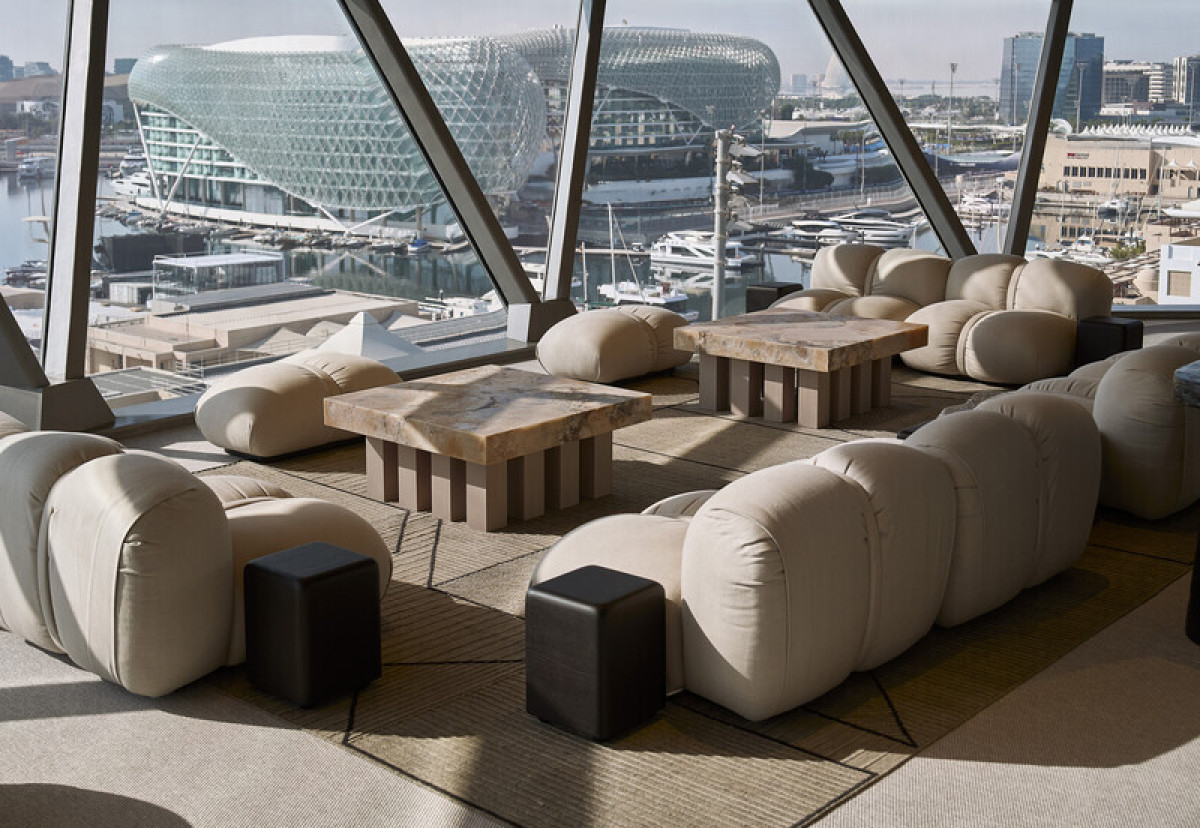17 Sep 2025

The narrowing cylinder of the Shams Tower, positioned at the axis of the finishing line, is reserved for the most important guests of the event. The viewing lounge is split between two indoor floors, crowned with a panoramic terrace shaded by a tented structure. Though all levels boast 360-degree views along the tower's oval footprint, the prime position faces the finishing line of the Yas Marina circuit.
The brief presented a dual challenge: to create a space that resonates with the drama of Formula 1, while showcasing Emirati hospitality, design and art in a contemporary way.
The journey starts at the ground-floor reception, where the sweeping curves of the blackened steel reception desk welcome the visitors. The contrast between the sleek metal and the tactile and gravity-defying work of prominent Emirati artist Afra Al Dhaheri is almost visceral. In another tongue-in-cheek reference to the race, a tire-like Carrara marble doughnut, bent and tied with a blue steel ribbon, stands as the work of local sculptor Shaikha al Mazrou.
From here, guests ascend to the lounge level, where they are greeted by a glistening black console made of papyrus-based biomaterial by Aya Moug and a suspended installation of recycled car tyres. Beyond, the space opens to a generous majlis with locally-made tumbled stone tables, its formal arrangement intended for pre-race meetings.
To the left of the lounge, "Sand Pearls", by the sister firm of T Sakhi Architecture and Design, takes a prominent spot, separating the majlis area from the dining area where guests enjoy Emirati cuisine and coffee. Tessa Tsaki describes the series that consists of seven spheres connected by a twisted silk rope as "prayer and meditation beads in various cultures. Scaled into a large sculpture, it embodies versatility, flexibility, and playfulness due to its multi-functional use serving as a seating or table, and its movable dynamic layout, which can be endless."
The west-facing part of the lounge maximises track views, yet the design resists fixed scenography. The pieces were selected for their interchangeability, allowing spontaneous rearrangement as guests break into smaller or larger groups, following as racing unfolds on different parts of the track.
Creative reuse, regional materials and makers, and innovative solutions were paramount to the design process.
While the design team chose iconic pieces from Moroso, Mattiazzi, and Mogg, local and regional makers and artists dominate the space. Collaboration with Omar al Gurg produced several modular pieces that serve as both seats and side tables.
Interspersed are accent pieces by other celebrated designers - the Takiya stool and bench by Aljoud Lootha, Braided armchair by Latifa Saeed, and Liminal table made of salt crystals by Hala Al Ani for Tanween by Tashkeel. These mix with design icons like Che Pakko, inspired by a stack of paper bound by rope, and cocoon-like pieces by Tokujin Yoshioka for Moroso. Smaller works by Alia Hussain Lootha and Nada Debs for Irthi add another regional touch.
For the bathrooms, the team engaged local metal fabricator Metal Fabrik to create custom bathroom vanities in sleek stainless steel; their intersecting sharp angles contrasted by twisting shiny pipes, another reference to high-performance engineering.
The east part of the tower faces the creek. Here, minimalist and customised Mattiazzi pieces, with their svelte vertical lines, maximise views toward the Ghaf tree grove across the water, a backdrop busy with yachts and occasional helicopters.
The journey around the core becomes gallery-like, showcasing Mohammed Ahmed Ibrahim's artwork - a shaky black and white checker revealing layers of colour underneath, echoing the iconic F1 race flag. His "Doorknockers" series brings visitors closer to Emirati vernacular, while Ruqaya Al Hashmi's diptych incorporates natural elements through pieces made of palm tree skin, revealing rich textures of intertwined fibres.
The terrace offers the race at its peak intensity. Between runs, guests relax in woven armchairs paired with artisanal tables, supported by hand-decorated majolica by artist Nicolò Morales for Paola Lenti, surrounded by lemon and orange trees. Vondom's Lava benches bring a lighter touch, particularly engaging younger visitors.